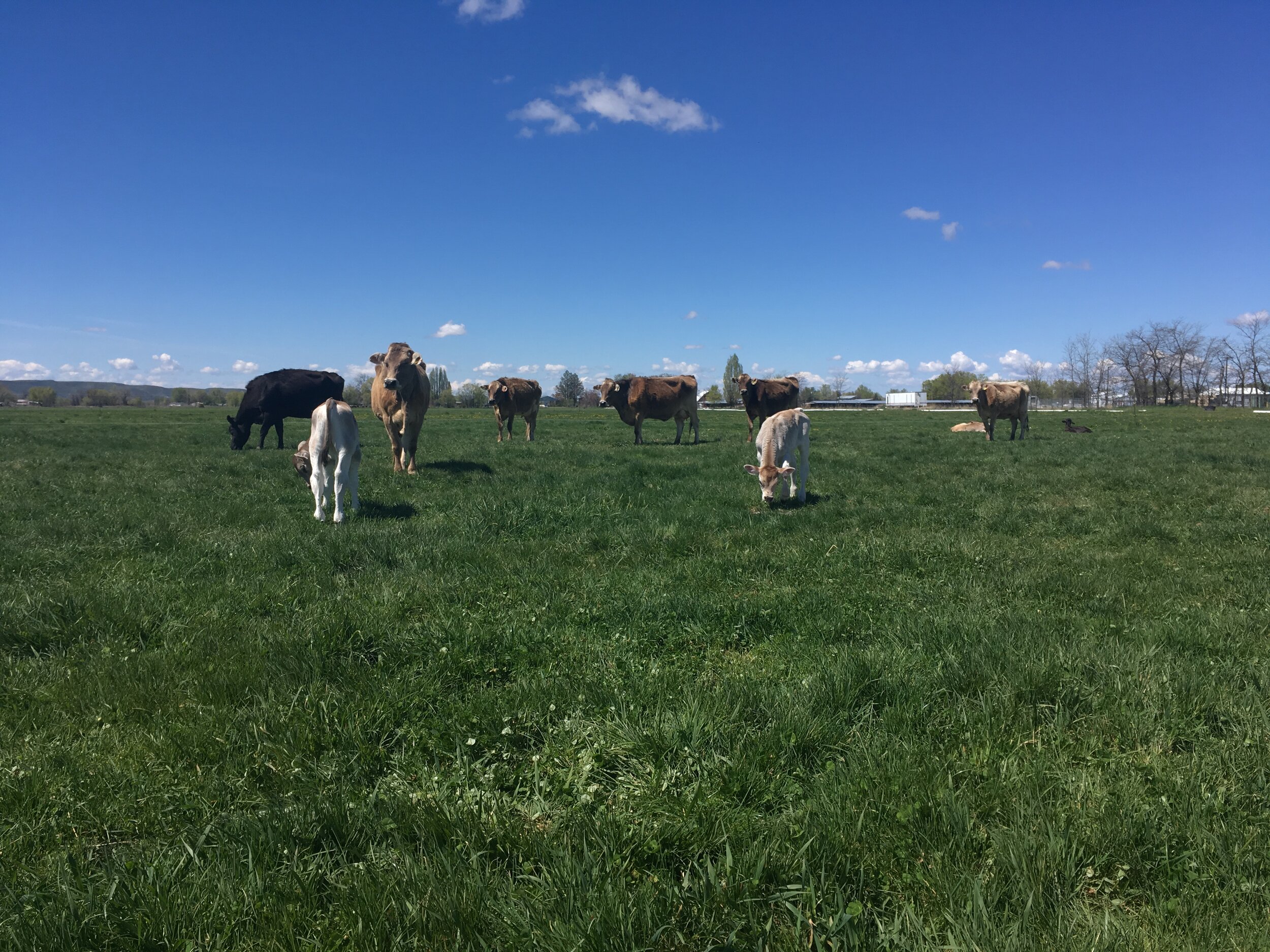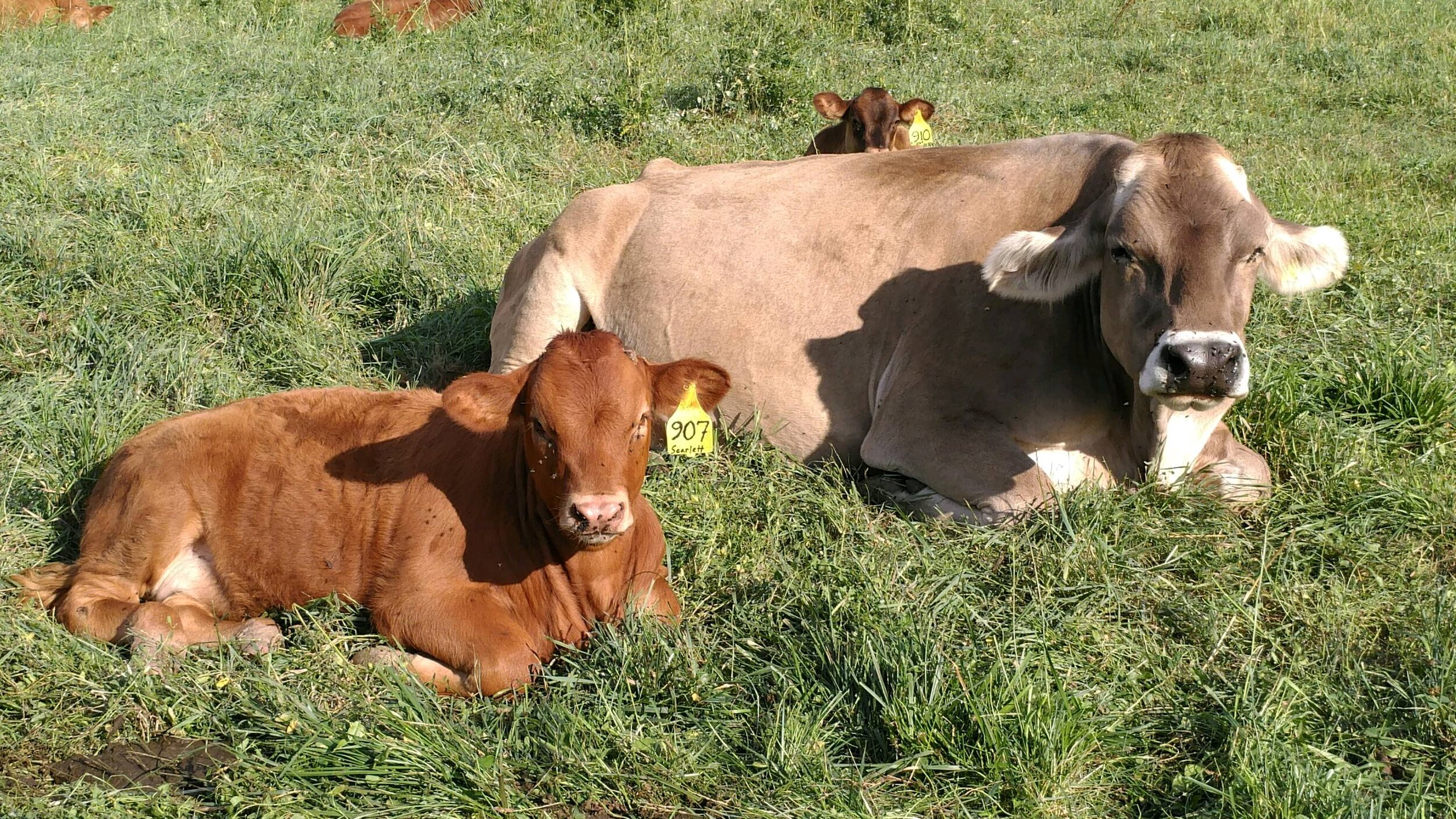There are many benefits to consuming beef that is organic and 100% grass fed and grass finished. What may be surprising are the specific benefits of eating beef (and other meats and eggs) that are soy and corn free.
Soy and corn are commonly fed to animals in the United States and throughout the industrialized world. This is not because soy and corn are ideal foods for livestock but rather because soy and corn are cheap and easy to grow, subsidized by governments (U.S. included), and these foods cause the animal to reach market weight more quickly than grass fed livestock.
Unfortunately, the rampant use of soy and corn in animal feed has a cost to the environment and to our health.
Problems with Corn and Soy
Sweet, red clover in our pasture.
Most corn and soy is genetically modified and heavily sprayed with the toxic herbicide glyphosate (RoundUp). When an animal consumes glyphosate, glyphosate builds up in the connective tissues, muscles, and joints of the animal. The problem with the presence of glyphosate in meats we eat is that our bodies will accept glyphosate in our connective tissues and joints because it is chemically similar to the amino acid glycine.
Because supermarket foods are laden with glyphosate (non-organic wheat may be the biggest culprit), the average American’s constant exposure to glyphosate is connected to several adverse health outcomes, including mineral deficiencies, gut dysbiosis (“leaky gut”), reduced neurotransmitter production (contributes to mental health disease like depression and anxiety), and a disruption of detoxification pathways that can lead to metal toxicity or even cancer.
A 2019 study of 1000 corn samples from 5 continents determined that 92% were contaminated with mycotoxins. Mycotoxins are fungal poisons that can cause a myriad of health issues, including breathing problems, lung inflammation, fever, and more serious long term conditions like cancer, fibromyalgia, heart problems, and lupus. The key is to avoid corn feed for animals because what the animal eats will be present in the meat of the animal upon consumption.
Saint John’s moms and babies enjoying green pasture.
In the U.S., 99% of cows are raised in concentrated animal feeding operations (CAFOs). This is done with a disregard for meat quality, health of our nation, and care for our environment. CAFOs are used because it’s low cost production, and these cows are frequently fed soy, corn, and wheat, and lived in cramped and unnatural settings. Lack of adequate nutrition causes animals to be more prone to disease and routine antibiotics are administered for disease prevention. These antibiotics are present in the meat of the cow and are ultimately transferred to the consumer. Yet another reason to choose organic, grass fed and grass finished.
The cheap and subsidized soybean has become so commonly used for animal and human food that it’s becoming increasingly difficult to avoid soy. Check your food labels at the supermarket and you will find soybean oil or other soy products in an abundance of packaged foods.
Soy contains phytoestrogens, estrogen-mimicking compounds that are present in the meat, milk, and eggs of animals that eat soy feed. When we consume phytoestrogens, our bodies can interpret this as the hormone estrogen. This may be a cause for low sperm counts in the developed world and the absolute nosedive testosterone levels have taken in the last 50 years.
“Since in America we tend to eat animal foods every day, the load of toxins from supermarket meat, eggs and dairy products can be very high and the effects profound, especially in growing children.
The solution? Purchase your meat, eggs and dairy products directly from a local farmer, one who practices pasture feeding and who uses non-medicated feed (preferably soy-free). In the process of protecting your family, you will also be supporting independent, conscientious farmers and a robust local economy.
”
Dandelions are a nutrient-dense favorite for our cows.
Quality of Beef
Ultimately, feeding cattle soy and corn doesn’t serve human health, bovine health, or the health of the environment. It does line the pockets of a few corporations. Soy and corn feed the cow but it doesn’t compare to the nutrition provided by grass fed beef.
Compared to conventional grain fed (soy and corn fed) beef, organic grass fed beef is:
10X higher in vitamin A
3X higher in vitamin E
Substantially higher in calcium, magnesium, potassium, & B vitamins
Lower in cholesterol
An abundant source of anti-cancer conjugated linoleic acid
Free of GMOS
Free of synthetic fertilizers
Free of hormones and antibiotics
Free of glyphosate and other pesticides or herbicides
From our perspective, prioritizing the quality of the beef and stewardship of the land means that we feed our cows organic grasses in well-tended pastures. We grow organic hay for the winter when grass growth stalls. As providers for people and as caretakers of the earth, we seek what is best for you and the world we inhabit, and will continue to offer a vision of sustainable agriculture for future generations.
Our organic, grass fed and grass finished beef is free of glyphosate, mycotoxins, and is good for the environment and your health. Choose organic and choose corn and soy free animal products everywhere you can. Healthy, strong families are the building blocks of our society and nation. Talk to your farmer, and know where your food comes from!
Resources
Of 1000 corn samples, 92% had mycotoxins
Why You Should Purchase Meat, Eggs, and Dairy Directly From a Farmer You Know


































